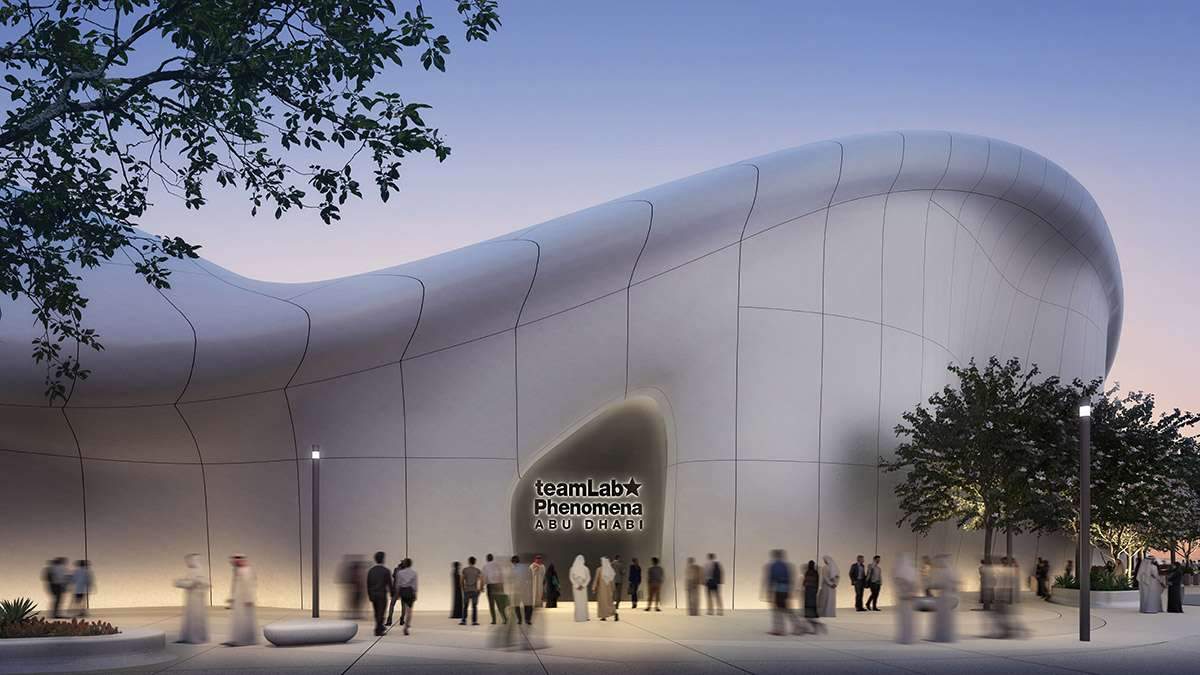The TeamLab Tokyo-based multidisciplinary art collective has revealed its design for a multi-sensory art space to be
a “new home for endless curiosity” on Saadiyat Island in Abu Dhabi, United Arab Emirates.
The new Lab Phenomena Abu Dhabi team has been designed to create a multi-sensory art experience featuring original,
ever-changing, and unique art installations in Abu Dhabi.

Design Features
The 17,000 square meter building will be the latest addition to other cultural buildings in the Saadiyat Cultural District,
including the new Abu Dhabi Natural History Museum by Mecanoo, Jean Nouvel Louvre Abu Dhabi,
Foster & Partners National Museum and the Adjaye Associates collection of three religious spaces for the family home. Abrahamic.
The new art space, which features smooth surfaces and flowing lines, is due to be completed in 2024.
According to a press release from teamLab,
the new art space is set to be an “immersive and inspiring space where the intersection of art and technology sparks curiosity,
imagination and creativity in everyone who visits.”
The building will offer one-of-a-kind installations that will be unique to Abu Dhabi,
created through an extensive experimental process.
Designing a multi-sensory art space on Saadiyat Island in Abu Dhabi
The Department of Culture and Tourism – Abu Dhabi (DCT Abu Dhabi) has also partnered with Miral,
the emirate’s leading destination and experiences builder, to develop the concept,
architecture and facilities, along with teamLab.

Design shape
The building is designed as a large cave structure where a large open staircase invites visitors to enter,
and the multiple large halls on the roofs of the building create different façade configurations as the building flows.
Distinctive artworks are created and shaped by the environment that produces the various phenomena.
The teamLab team worked with Abu Dhabi-based MZ Architects to create a unique architecture and to be able to play an important role in providing artworks
with an environment that develops freely and organically, as if it were life forms themselves.
The team explained, “The experience will be unique to each visitor, changing with each visit,
as they discover a place where they explore without boundaries and push the boundaries of their imagination.
At teamLab Phenomena, visitors will be immersed in a world that changes and evolves naturally through the participation and actions of the people in it,
and it is precisely this physical experience that can expand our senses of value.
The future is built on the sum of people’s creativity.
The artworks in Team Lab Abu Dhabi Phenomena do not exist independently but are created through the environment that produces the various phenomena, stabilizing their structure.
Objects like stones and man-made creations maintain a stable structure on their own,
and unlike these,
the existence of artworks in TeamLab Phenomena Abu Dhabi depends on their environment.
The environment produces phenomena and establishes their structure – these stable phenomena are what create the existence of artworks.
Environmental phenomena spring from the material substances that were responsible for maintaining the structures of existence,
the elements such as air, water and light that permeate our daily lives transformed through their environment into unique phenomena that become works of art.
Designing a multi-sensory art space on Saadiyat Island in Abu Dhabi
Designing a multi-sensory art space on Saadiyat Island in Abu Dhabi
The limits of their existence are vague and persistent. Even if people destroy the work,
the work will still exist as long as its environment is preserved, on the contrary,
the work will disappear if the environment is not preserved, with the passage of time, people’s consciousness will expand from existence itself to the environment.
A stone can continue to exist in a box that is closed, from the outside world,
but life cannot maintain its existence in such a box because it was created by its environment.
Life is a miraculous phenomenon that emerges from the continuous flow of the world,” Inoko added.
The new building was developed by the Department of Culture and Tourism – Abu Dhabi (DCT Abu Dhabi),
which is behind the new Mecanoo Museum of Natural History in Abu Dhabi, Jean Nouvel’s Louvre Abu Dhabi, and the Zayed National Museum.
Saadiyat Cultural District is an ambitious project and will be one of the world’s preeminent cultural destinations.
With museums, cultural centers and educational institutions,
the region will boast one of the highest concentrations of cultural experience in the world.
Saadiyat Cultural District will also soon include the Zayed National Museum designed by Foster + Partners, the National Museum of the United Arab Emirates,
the Guggenheim Abu Dhabi Museum of Frank Gehry Art, with a focus on international modern and contemporary art,
and the Abrahamic Family House by Adjaye Associates, comprising of three religious spaces In one complex – a mosque,
a synagogue and a church – to inspire and promote acceptance and peaceful coexistence among people of all faiths.
For more architectural news


 العربية
العربية
